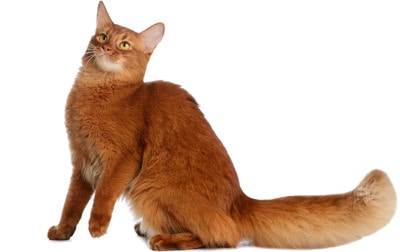Type the name of the breed you're looking for below
[wpdreams_ajaxsearchlite] Don't see the breed your're looking for? Click here and let us know!
Breed Characteristics
1 paw - breed exhibits the least amount of this characteristic
5 paws - breed exhibits most amount of this characteristic
Somali
| Origin And History | No one knows for sure when and where the first Somali appeared; some proponents think that the long coat was a spontaneous natural mutation in the Abyssinian. Genetic studies indicate, however, that the Somali probably originated around the turn of the century in England when breeders, low on breeding stock, used long haired cats in their Abyssinian breeding programs. In the late 1910s and in the late 1940s, during the aftermath of World Wars I and II, when so many breeds had dwindled to near extinction, breeders were forced to mix other breeds into their Abyssinian bloodlines to keep the breed going. Raby Chuffa of Selene, a male Abyssinian that came to the United States from Britain in 1953, and that appears on the pedigrees of many Abyssinians, is considered the father of the Somali breed on this continent; all Canadian and American Somalis can be traced back to this cat. Raby Chuffa's pedigree can be traced back to Roverdale Purrkins, an English Abyssinian female whose dam, Mrs. Mews, was of unknown ancestry and probably carried the longhair gene. Mrs. Mews was given to breeder Janet Robertson by a sailor during WWII. Mrs. Mews later produced two kittens: Roverdale Purrkins, registered as an Abyssinian, and a black unregistered male. Robertson used Purrkins to start her Roverdale cattery. Her cats and other Abyssinians of British origin were exported to Europe, Canada, Australia, New Zealand, and the United States. When long haired kittens cropped up in Abyssinian litters (possible whenever two Abyssinians carrying the recessive gene for long hair were bred together), the kittens were quietly disposed of, since no breeder wanted to be thought to have Abyssinian lines that were 'tainted' with un-Abyssinian genes. It wasn't until the 1960s that breeders, seeing the appeal of a long haired version of a breed that was rapidly gaining popularity in the United States, began seriously trying to turn these castaways into a breed of their own. At the same time, breeders in Canada, Europe, Australia, and New Zealand began working with the new breed as well. Some Abyssinian breeders wanted nothing to do with these long haired nonconformists and did not want to encourage the tenuous connection that the name 'Longhaired Abyssinian' would produce. Abyssinian breeder Evelyn Mague, one of the first U.S. breeders to work with the developing long haired breed, came up with the name 'Somali' because Somalia borders Ethiopia, the country formerly called Abyssinia for which the Abyssinian was named. |
| Personality | With all the virtues of the Abyssinian and adorned by a gorgeous semi-long coat, the Somali is a beautiful and lively addition to any household. Don't get a Somali if you want a cat that can be taken for a furry doorstop, or if you want a cat that will do your bidding. Like the Abyssinian, the Somali is active, curious, and high-spirited, and loves to prance around the house, opening cupboards and generally getting into mischief. Their voices are soft, their minds active, and their food dishes are always empty. They also tend to be determined cats: Once they get an idea in their furry little heads, there's no dissuading them. They're not aggressive or unfriendly, just tenacious. Somalis are affectionate, but are not lap cats. They don't like to be cuddled and would rather be near than on you. They do, however, want to be involved in every aspect of your life. Open a drawer and your Somali will be there to peer in. |
Physical Attributes
| Appearance | The Somali is a well-proportioned, medium-sized cat with firm muscular development. The medium-length, soft and silky coat requires little grooming. The coat is longer around the ruff, tummy, and britches – with that lovely, fluffy, full tail. The feet have tufts of hair between the toes. The large, almond-shaped eyes range in color from intense green to rich copper. The coat pattern is agouti (also called “ticked”), which has multiple bands of colour on each hair. The Somali comes in four recognized colours in CFA: ruddy, red, blue, and fawn. The colours showing in the ticked fur of the back and tail harmonize with the solid, lighter colour on the cat’s undersides. |
| Health | Like the Abyssinian, Somalis are susceptible to gingivitis, tooth decay, and the renal disease amyloidosis. |



